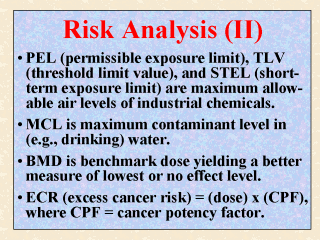| front |1 |2 |3 |4 |5 |6 |7 |8 |9 |10 |11 |12 |13 |14 |15 |16 |17 |18 |19 |20 |21 |22 |23 |24 |25 |26 |27 |review |
 |
PEL (permissible
exposure limits), along with TLV (threshold limit values), STEL (short-term exposure
limits), and the like, are the maximum atmospheric concentrations of industrial chemicals
that a work group or community presumably can be exposed to without causing appreciable
adverse effects. These levels are adopted primarily by OSHA of the U.S. Department of
Labor. MCL, as used primarily by USEPA, is the maximum contaminant level of a chemical in
water delivered to any user of a public water system. BMD (benchmark dose), of which the derivation was briefly given in Slide 10, could represent a lower confidence limit on a dose that produces a certain small percentage (e.g., 5 or 10%) increase in a particular adverse effect. It is hence a more accurately quantified LOEL (lowest observed effect level). BMC (benchmark concentration) differs from BMD in that it relates to the contaminantís concentration to be exposed to, instead of the dose received. For carcinogens, excess lifetime risk is typically calculated by multiplying an estimated dose by the associated CPF (cancer potency factor, typically in mg/kg/day-1). This product represents an upper-bound on the probability of having excess cancer risk (ECR) from the lifetime exposure at issue. This probability is usually expressed as a population risk, such as 1 x 10-6, which means that one in 1 million exposed persons is expected to develop the cancer. Since ECR is defined as the product of (dose) x (CPF), it follows that dose = ECR/CPF. The safe dose can hence be estimated in terms of CPF alone, provided that an acceptable level of ECR has been determined. |